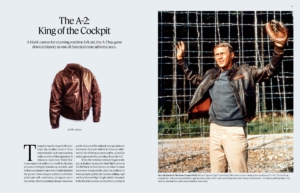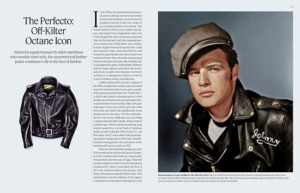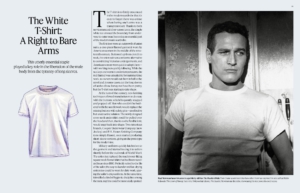Lots of items from modern men’s wardrobes come loaded with history, were featured in cult movies worn by famous actors or have a past strongly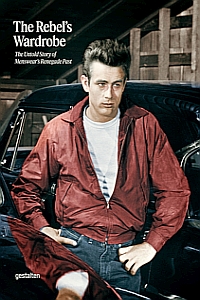 connected to popular culture, even if many are not aware of that.
connected to popular culture, even if many are not aware of that.
Everyday apparel, such as the baseball cap, Dr. Marten’s boots, a pair of jeans, chinos or the leather jacket: not only are these just comfortable to wear, today they can be combined easily with other classical menswear items, even though these may come from very different lineages.
Several of such global icons, when worn in popular movies of the 1950s and 1960s, in particular, originally were produced for a military purpose, such as the MA-1, A-1, N-1, M-65 jacket, A-2 bomber pilot jacket, combat boots, including what was to become the civilian desert boot, pea coat, duffel coat, parka or cargo pants.
Not only was such apparel easily available from surplus stores, it also was extremely good value, as for example jackets and boots were durable and would last many years.
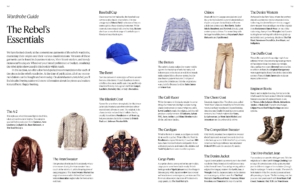 Such was also the primary purpose of (mostly American) work wear featured here, like blue jeans, dungarees or the classic engineer boot.
Such was also the primary purpose of (mostly American) work wear featured here, like blue jeans, dungarees or the classic engineer boot.
Blue jeans and heavy denim not only were the standard work wear of farmers, engineers, factory workers or laborers, in the early 1950s, they became the favorite apparel of teenagers who watched screen icons like Elvis, James Dean and others who wore it with dignity, thus elevating the simple but sturdy outfit to a cultural good of some desirability.
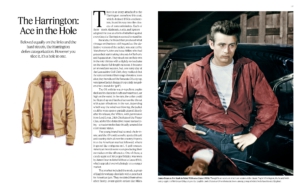 Even though there not the real pioneers, as it were, early actors like Tom Mix, as well as unnamed extras and cowboys of the early B-Westerns, never changed their clothes for the film shooting, but arrived on the set wearing their everyday ranch work apparel.
Even though there not the real pioneers, as it were, early actors like Tom Mix, as well as unnamed extras and cowboys of the early B-Westerns, never changed their clothes for the film shooting, but arrived on the set wearing their everyday ranch work apparel.
The blending of work wear and popular culture spread all across the world, transported through movies and by GIs, who wore jeans off-duty.
Editors Thomas Stege Bojer and Bryan Szabo, the men behind the respected denim and appraisal website Denimhunters.com in several texts here share their knowledge about the classic pieces of men’s wardrobe of all kinds and brands and add lots of anecdotes and historical data.
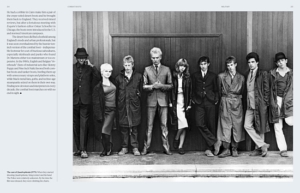 Going back roughly 100 years into the history of men’s apparel, work wear, sportswear, and movie production and costume design, the collection of selected menswear items is impressive. As the “rebel” apparel naturally had an impact on fashion design and trends, youth cultures and even collecting, as some of the classical and vintage items featured here are quite valuable in certain collector’s circles. For example, Schott Perfecto or Levi’s Type 1 jackets, or motorcycle competition sweaters are worth thousands of dollars in good condition.
Going back roughly 100 years into the history of men’s apparel, work wear, sportswear, and movie production and costume design, the collection of selected menswear items is impressive. As the “rebel” apparel naturally had an impact on fashion design and trends, youth cultures and even collecting, as some of the classical and vintage items featured here are quite valuable in certain collector’s circles. For example, Schott Perfecto or Levi’s Type 1 jackets, or motorcycle competition sweaters are worth thousands of dollars in good condition.
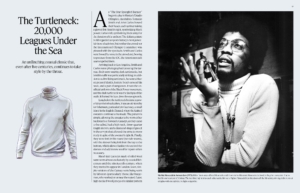 The Rebel’s Wardrobe is both a contemporary menswear lexicon and shopping list for those interested in the classic and timeless menswear with roughly three pages devoted to each item, thereby listing origin, main manufacturer and most prominent fans. The book comes with hundreds of great photos and details, mostly film stills (meet Steve McQueen, Dennis Hopper, Dean Martin, Paul Newman, Robert Mitchum, Kirk Douglass, Clark Gable, Marlon Brando and others), footage from production sets, military documentaries and sport events.
The Rebel’s Wardrobe is both a contemporary menswear lexicon and shopping list for those interested in the classic and timeless menswear with roughly three pages devoted to each item, thereby listing origin, main manufacturer and most prominent fans. The book comes with hundreds of great photos and details, mostly film stills (meet Steve McQueen, Dennis Hopper, Dean Martin, Paul Newman, Robert Mitchum, Kirk Douglass, Clark Gable, Marlon Brando and others), footage from production sets, military documentaries and sport events.
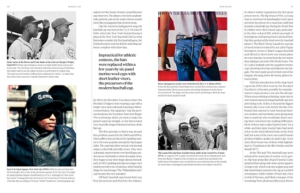 Not to forget pictures of Mods, rockers, bikers with cafe racer jackets, skinheads and sportsmen in action. Fashion always was disinterested in factions, class and nationality, when it made links between seemingly disparate groups and incorporated designs from military and sports. The editors masterfully tell many surprising stories that encompass the origins of the timeless classics. The 9 × 11 ½ inches full color hardcover is stitch bound, and the 288 pages of heavy photo paper make up for almost 4 lbs.
Not to forget pictures of Mods, rockers, bikers with cafe racer jackets, skinheads and sportsmen in action. Fashion always was disinterested in factions, class and nationality, when it made links between seemingly disparate groups and incorporated designs from military and sports. The editors masterfully tell many surprising stories that encompass the origins of the timeless classics. The 9 × 11 ½ inches full color hardcover is stitch bound, and the 288 pages of heavy photo paper make up for almost 4 lbs.
Review by Dr. A. Ebert © 2023
gestalten, Robert Klanten, Thomas Stege Bojer, Bryan Szabo (eds.) The Rebel’s Wardrobe. The Untold Story of Menswear’s Renegade Past. Die Gestalten Verlag, 2022, 288 p., ISBN 978-3-96704-072-2

